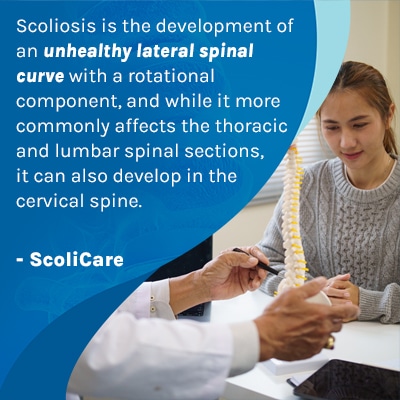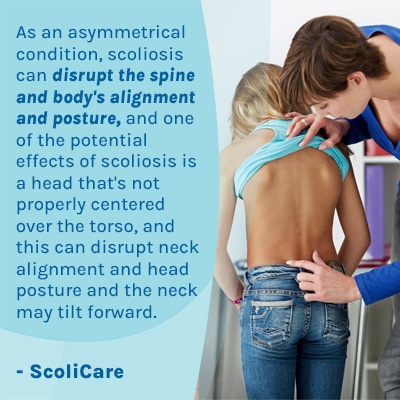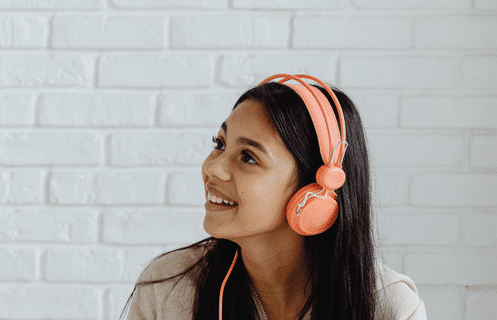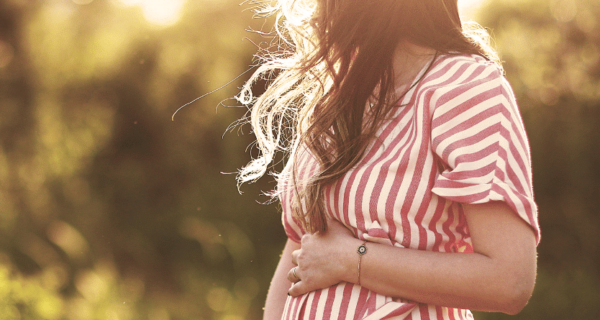The spine’s healthy curves are key to its overall health and function, and the spine has three main sections including the cervical spine, thoracic spine, and the lumbar spine. The cervical spine refers to the neck, and cervical lordosis refers to the neck’s inward-bending spinal curvature.
Scoliosis causes the development of an unhealthy spinal curvature and has the potential to impact the cervical spine’s healthy lordosis due to direct effects of the scoliosis, compensatory curves, postural changes and/or muscle tension.
To understand the potential impact of scoliosis on cervical lordosis, the role of the cervical spine should be explored.
The Cervical Spine
As the spine is one long complex structure with three main sections, the health of a single section can impact the other regions, and the cervical spine, the thoracic spine, and the lumbar spine all have unique roles to play in how the spine functions (1).
The lumbar spine’s alignment feeds off the alignment in the pelvis, and it has to support the weight of the thoracic and cervical spinal sections above, the trunk, and its vertebrae. For this reason, the lumbar spine, or lower back, can be particularly vulnerable to strain as it feels the effects of strenuous movements.
The thoracic spine is the largest spinal section, and as the only portion of the spine that connects to the rib cage, it helps stabilize the rib cage, protect important organs, support the upper body, and also protect the spinal cord.
The cervical spine refers to the neck and contains the spine’s first seven vertebral bodies.
Like all parts of the spine, the cervical spine also has to protect the spinal cord, support the weight of the head, facilitate a range of motion in the neck for head movement, and more (1).
As the first section of the spinal column, the cervical spine connects the brain to the spine and the rest of the body.
Let’s take a closer look at the functions of the cervical spine to better understand the potential effects of a loss of the cervical spine’s healthy curve.
Protecting the Spinal Cord
The spinal canal contains the spinal cord: a bundle of 31 pairs of spinal nerves that project from the cord and branch off throughout the body.
The spinal nerves are involved in sensory input, motor output, autonomic responses, and more, so each spinal section contains important spinal nerves within that need to be protected so they can function properly (1).
The nerves of the cervical spine facilitate motor control (movement) of the head, neck, shoulder, and arm, while also providing sensation to the upper body.

Head Support
As the first spinal section, the cervical spine provides structural support for the head by supporting its weight.
If the cervical spine has lost its healthy lordosis, its ability to support the weight of the head can be disrupted, potentially causing neck and shoulder pain (2).
Wide Range of Neck Movement
The head’s ability to look to the left or right, up and down, depends on the health of the cervical spine and its range of motion (1).
A neck’s healthy curve has to be in place so it can function optimally by supporting the weight of the head and facilitating a variety of movements including extension (tilting backward), flexion (tilting forward), rotation (turning the head), and lateral bending (side-to-side tilting).
In addition, the cervical spine also contains vertebral arteries that maintain a constant supply of blood to the brain.
So what happens if the cervical spine’s lordosis is lost?
Cervical Lordosis
There are two main types of spinal curves known as kyphosis and lordosis.
Kyphosis characterizes the thoracic spine as its curve-type bends backwards, while a lordotic curve can be found in the cervical and lumbar spinal sections where the spine curves inwards.
There are different curve sizes, and a healthy range of cervical lordosis can fall between 20 and 40 degrees.
There are also different ways the cervical spine can lose its healthy lordosis; curves can become flattered (hypolordotic) at less than 20 degrees and an excessive inward curve (hyperlordotic) at 40+ degrees can develop.
There can also be a reversal of cervical lordosis that involves the vertebrae of the cervical spine bending backward.
The cervical spine can lose its healthy degree of cervical lordosis for a number of reasons, one of which is scoliosis (3).
Scoliosis and Lordosis
Scoliosis is the development of an unhealthy lateral spinal curve with a rotational component, and while it more commonly affects the thoracic and lumbar spinal sections, it can also develop in the cervical spine (3).
Scoliosis can develop in any one section of the spine, or in more than one section as a combined scoliosis.
Scoliosis can impact cervical lordosis in a number of ways.
A Loss of Cervical Lordosis
In cases of cervical scoliosis, a direct effect can be a loss of the cervical spine’s lordosis as it causes the cervical spine to bend and rotate unnaturally (3).
A loss of cervical lordosis can involve the neck losing its curve and becoming excessively straight, the lordosis becoming excessive, or a curve reversal.
If the spine loses its cervical lordosis, the neck can become stiff, sore, headaches can develop, and the neck can lose its range of motion (2, 3).
Compensatory Curves
Even in cases of thoracic scoliosis, lumbar scoliosis, and thoracolumbar scoliosis that develop in the lower thoracic and upper lumbar spine, the cervical spine’s healthy curve can be affected if it develops a compensatory curve.
The spine and body can make a number of compensations in response to the uneven forces of scoliosis.
Particularly in cases of lumbar scoliosis, the cervical spine can respond to the development of an unnatural spinal curve in the lumbar spine by adding a compensatory curve in the cervical spine, attempting to counteract the uneven forces of the first unnatural spinal curve.
Postural Changes
It’s the uneven forces of scoliosis that cause its main effect of postural deviation, and postural changes can also affect the cervical spine’s lordosis.
 As an asymmetrical condition, scoliosis can disrupt the spine and body’s alignment and posture, and one of the potential effects of scoliosis is a head that’s not properly centered over the torso, and this can disrupt neck alignment and head posture and the the neck may tilt forward (2).
As an asymmetrical condition, scoliosis can disrupt the spine and body’s alignment and posture, and one of the potential effects of scoliosis is a head that’s not properly centered over the torso, and this can disrupt neck alignment and head posture and the the neck may tilt forward (2).
Forward head posture increases the weight of the head on the neck, and this can further strain the neck and disrupt its cervical lordosis (2).
A loss of cervical lordosis doesn’t just introduce adverse spinal tension to the cervical spine; it can also contribute to the body becoming more asymmetrical as the head not being centered over the torso can contribute to the entire body being off balance.
As a progressive condition, these changes can become more noticeable over time, further disrupting the spine and body’s alignment, balance, and stability, hence the benefit of a proactive treatment approach that prioritizes preventing progression.
Scoliosis can also impact the neck’s lordotic curve by causing muscle tension as a common scoliosis symptom is muscular imbalance (3).
Muscular Imbalance
If the spine is not aligned, it doesn’t just affect the spine, but also its immediate surroundings, including the muscles closest to an affected spinal section.
If cervical scoliosis causes the neck and shoulder muscles to become unbalanced, this can further strain the neck, contributing to forward head posture and tight and weak muscles in the area (2, 3).
Conclusion
So can scoliosis impact the neck’s healthy lordosis? Scoliosis has the potential to cause a loss of the cervical spine’s healthy lordosis by developing an unnatural curve, developing a compensatory curve, postural deviation, and/or muscle tension.
Cervical lordosis refers to the neck’s characteristic inward-bending spinal curvature, and if the neck loses its healthy range of lordosis, a variety of symptoms can develop from neck and shoulder pain to tension headaches and nerve compression.
Scoliosis, as an unnatural spinal curve, can impact cervical lordosis in a number of ways, but the most important impact to understand is the potential impact of treatment.
Proactive treatment can work towards counteracting progression so patients may not experience many of the effects and symptoms mentioned.
While treatment results can never be guaranteed, the best way to minimize the condition’s potential effects is to treat the condition proactively; scoliosis can be highly treatable.
So the level of impact scoliosis can have on cervical lordosis can also be shaped by whether or not a patient is undergoing treatment, and the type of treatment.
Here at ScoliCare, we promote an evidence-based approach to conservative scoliosis treatment that works towards restoring the spine’s healthy curves and alignment by integrating a number of power treatment disciplines.
References:
- Joshua T. Kaiser; Vamsi Reddy; Marjorie V. Launico; Julian G. Lugo-Pico.Anatomy, Head and Neck: Cervical Vertebrae
- Mahmoud, N.F., Hassan, K.A., Abdelmajeed, S.F. et al. The Relationship Between Forward Head Posture and Neck Pain: a Systematic Review and Meta-Analysis. Curr Rev Musculoskelet Med 12, 562–577 (2019). https://doi.org/10.1007/s12178-019-09594-y
- Mesfin A, Bakhsh WR, Chuntarapas T, Riew KD. Cervical Scoliosis: Clinical and Radiographic Outcomes. Global Spine Journal. 2015;6(1):7-13. doi:10.1055/s-0035-1554776


